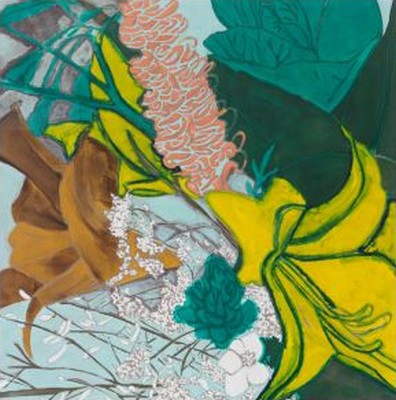Francesco Clemente: Winter Flowers
LGDR & Wei, Hong Kong
March 20 – April 29 2023
Winter Flowers XL, 2023
Pigment on canvas, 72 × 72 inches (182.9 × 182.9 cm)
© Francesco Clemente. Courtesy LGDR
LGDR & Wei presents Winter Flowers, Francesco Clemente’s first solo exhibition in Hong Kong. Featuring fourteen new paintings, all completed in 2023, from the artist’s radiant series by the same name, this presentation meditates on resilience, presence, and pleasure.
Initiated in 2010, Francesco Clemente’s Winter Flowers series emerged from a collaboration with the artist’s wife of nearly five decades, the actress and choreographer Alba Primiceri. One winter, Alba brought an assortment of flowers to Clemente’s New York studio. Plucked from the city’s parks and gardens, these blooms had survived the cold. Inspired by their enduring beauty, Clemente embarked on a series of floral paintings using a carefully determined selection of plant and vegetable pigments. As they took form, the paintings’ relation to the winter season became consonant with the artist’s contemplation of old age. While the flower has been used in traditional vanitas paintings to represent impermanence and the inevitability of decay, Francesco Clemente depicts blossoms to celebrate the beauty that can be found in all stages of life.
The Winter Flowers canvases, each a large square format, feature abundant displays of color, texture, and form. Rhythmic compositions of petals, leaves, stamen, and seed pods move between abstraction and figuration. The largest two canvases are painted in grisaille, a painting technique in which an image is created entirely in shades of gray. Inspired by the grisaille works of the late Baroque painter Luca Giordano, from Clemente’s hometown of Naples, as well as contemporary Balinese grisaille painting, the artist has worked in this manner in previous series, including his Grisaille Self-Portraits of the late 1990s. Here, we see Francesco Clemente applying grisaille to his Winter Flowers for the first time.
The materials Francesco Clemente selected for the series mandate a slow execution in several phases, imbuing the works with an energy of spiritual contemplation. Clemente has compared his process in painting these canvases to that of weaving, wherein compositional threads appear and disappear. Rather than developing in a linear fashion, the paintings grow radially, in surprising directions from various centers of interest. This mode of creating, he explains, corresponds most to his understanding of consciousness: “I believe that the most accurate description of our consciousness is continuity of discontinuity. So, I indicate with my work the fact that we have a fragmented self and I’m interested in the gaps that separate all our different personas.”
Throughout his career, Francesco Clemente has returned to botanical motifs, whether as ornamental vegetation or symbolically redolent perennials. With Winter Flowers, the artist offers a deeply personal yet universally resonant reflection on temporality and joy.
FRANCESCO CLEMENTE
For over five decades, Francesco Clemente has forged a singular career that seeks intercultural resonance, addressing the philosophical dualities of mind and body, freedom and constraint, and part and whole. In paintings, prints, frescoes, photography, book editions, and installations, he nurtures a signature poetic intensity, using metaphor and symbolism to consider the nature of the self. Dividing his time between New York and Varanasi, India, Clemente is inspired by the Tantra traditions of India and Tibet, Beat poetry, the ritualism of Joseph Beuys, and Greco-Roman art. His frequently collaborative practice has been linked to the Italian Transavanguardia group of the late 1970s as well as New York’s concurrent neo-expressionism. Clemente frequently turns to portraiture and has painted, among others, Jean-Michel Basquiat, Toni Morrison, and Christy Turlington.
Born in Naples, Italy, in 1952, Francesco Clemente studied architecture at the Sapienza University of Rome. Following his participation in the 1980 Venice Biennale, he was critically lauded as a leader of the “return to figuration.” In 1981, with his wife Alba, he relocated to downtown Manhattan, where he collaborated with such figures as Basquiat, Andy Warhol, Allen Ginsberg, and Rene Ricard. He founded the imprint Hanuman Books with Raymond Foye in 1986, and in 1998, he created the portraits that were featured in Alfonso Cuarón’s film Great Expectations. Since he was nineteen, the artist has spent significant time in India, studying Sanskrit, literature, and collaborating with local artisans
Major retrospectives of Francesco Clemente’s artwork have been organized by the John and Mable Ringling Museum of Art, Sarasota (1985, traveled to the Walker Art Center, Minneapolis; Dallas Museum of Art; University Art Museum, Berkeley; Albright-Knox Art Gallery, Buffalo; and Museum of Contemporary Art, Los Angeles); Centre Pompidou, Paris (1994); Sezon Museum of Modern Art, Tokyo (1994); Solomon R. Guggenheim Museum, New York (1999, traveled to Guggenheim Bilbao); Schirn Kunsthalle Frankfurt (2011); and the Albertina Museum (2022), among other venues. His work is featured in prominent museum collections worldwide, including the Art Institute of Chicago; Miami Art Museum; Kunstmuseum Basel; Metropolitan Museum of Art and Museum of Modern Art, New York. In 2002, Clemente was elected to the American Academy of Arts and Letters.
LGDR & WEI
2 Ice House Street, Central, Hong Kong

